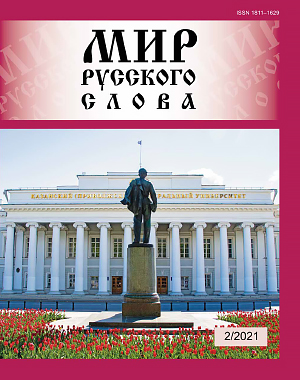Maya Kucherskaya’s Columns: Linguistic, Stylistic and Structural Features
DOI:
https://doi.org/10.24412/1811-1629-2021-2-36-44Abstract
The author argues that a column, being one of the newest journalistic genres, is a complex phenomenon characterized by a free type of narrative. The text of a column is strictly regulated in terms of volume; the journalist covers an event, which is relevant from his/her point of view, in a text usually of about 3,000 characters. The columns are of the same type in their structure: they often consist of six paragraphs. The first paragraph introduces the problem chosen into the discussion field, the last one gives a variant of solution to this problem. The second and third paragraphs introduce the reader to the described situation. The fifth one convinces the reader in the truth of the columnist’s judgment. The fourth paragraph may be regarded optional, since it either develops the ideas of the third paragraph or prepares a general conclusion. The articles written by Maya Kucherskaya mostly belong to topical or date columns and are dedicated to eternal values and their refraction in temporary being: one’s attitude to good and evil, death and life, love and hate, authenticity and falsehood, fear and fearlessness, sin and holiness, isolation and continuity, spirituality and earthliness, past and present, literature as reflection of everything that happens to an individual and to the society as a whole, as well as to specific literary works and their authors. Within the framework of her chosen persuasive strategy, the journalist selects the necessary linguistic and stylistic means, such as irony, intertextuality, stylistic dissonance and various syntactic means of expression. Based on the analysis, one can identify both Kucherskaya’s favorite means of image creating, and the effects that these images are producing. For example, the irony in Kucherskaya’s columns is created mostly by expanding the compatibility of lexical units. Allusions, the inclusion of precedent texts and quotations should be singled out as means of creating intertextuality. Stylistic dissonance is often created by inclusion of colloquial expressions in a different context and becomes a means of highlighting the meanings that are important for the author. Rhetorical questions form the controversy nature of the text. Kucherskaya’s favorite syntactic means of expressiveness is parceling, the function of which is to increase the categoricalness of the author’s judgments, which is achieved with the help of a bright and very emotional laconicism that does not provide for outside objections. Thus the dominance of the strategy of subjective argumentation makes Kucherskaya to choose linguistic and stylistic tools that have a strong influencing effect. Each of these tools specializes in the transmission of the author’s meanings / intentions assigned to it and is tied to a specific place in the structure of the columns
Keywords:
journalistic column, columns writing, structure, persuasive strategy, linguistic and stylistic tools, writer’s language, media language
Downloads
References
Справочные материалы
Литература
Голоднов 2003 — Голоднов А. В. Лингвопрагматические особенности персуазивной коммуникации (на примере современной немецкоязычной рекламы). СПб.: РГПУ им. А. И. Герцена, 2003. 247 с.
References
Downloads
Published
How to Cite
Issue
Section
License
Articles of "The World of Russian Word" are open access distributed under the terms of the License Agreement with Saint Petersburg State University, which permits to the authors unrestricted distribution and self-archiving free of charge.




